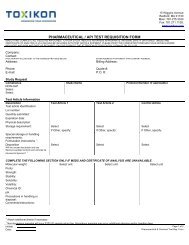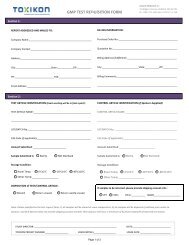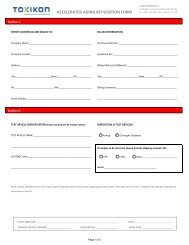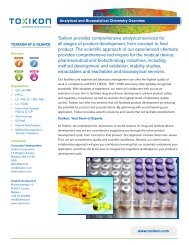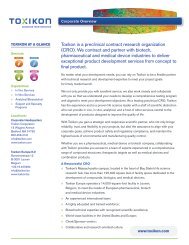Medical Device Testing Guide - Toxikon Corporation
Medical Device Testing Guide - Toxikon Corporation
Medical Device Testing Guide - Toxikon Corporation
Create successful ePaper yourself
Turn your PDF publications into a flip-book with our unique Google optimized e-Paper software.
BIOBURDEN TESTING<br />
Rev. May 2010<br />
Purpose: The Bioburden test is carried out in order to determine the total number of viable microorganisms on a medical<br />
device. Bioburdens are performed prior to sterilization after all in-process steps are completed. The dose used for effective<br />
radiation sterilization is determined by the resulting bioburden counts. Routine bioburden testing acts a monitoring system<br />
which may alert possible production problems which could lead to inadequate sterilization or possible product recall.<br />
RB01-1<br />
Bioburden Validation Repetitive (Exhaustive) Recovery Method-Sample needed: 3-10 non-sterile units<br />
The repetitive (exhaustive) recovery method uses the naturally occurring bioburden of the product to determine the efficiency<br />
of the recovery of the naturally occurring bioburden on a test article. The extraction method (stomaching, ultrasonicating,<br />
shaking, flushing, etc) is repeated on each test article until no significant increase in the number of recovered microorganisms is<br />
observed. The goal is to recover all viable microorganisms by washing the test article several times. The recovery fluid can be<br />
enumerated by membrane filtration, pour plating, spread plating, and incubated under specific conditions (aerobic bacteria and<br />
spores: 30-35°C for 2 to 5 days, Fungi (mold and yeast): 20-25 °C for 5 to 7 days, Anaerobic bacteria: 30-35 °C for 3 to 5<br />
days). The number of viable microorganisms (colony forming units (CFU)) recovered from the first extraction are compared to<br />
the total CFU recovered from the sum of all washes to calculate a percent recovery. A correction factor is then calculated which<br />
is applied to the Bioburden test numbers for the product. The resulting CFU recovered from one extraction is multiplied by the<br />
correction factor to determine the total bioburden of a product. This bioburden value is used to determine the required gamma<br />
radiation sterilization dose for the test article. (Refer to Table B.1 of the ANSI/AAMI/ISO 11137 guidelines for dose<br />
determination).<br />
Approximate turnaround time is one week<br />
RB01-2<br />
Bioburden Validation Spore Inoculation-Sample needed: 3-10 non-sterile units<br />
The spore inoculation method determines the efficiency of recovering the naturally occurring bioburden on a test article by<br />
creating an artificial bioburden and establishing recovery efficiencies and a correction factor. Each test article is inoculated<br />
with a known number of organisms, typically 1 10 2 CFU of Bacillus subtilis, and allowed to dry. The recovery method best<br />
suited for the particular test article (stomaching, ultrasonicating, shaking, flushing, etc) is used to remove the microorganisms.<br />
The recovery fluid can be enumerated by membrane filtration, pour plating, spread plating, and incubated under specific<br />
conditions (Aerobic bacteria and spores: 30-35°C for 2 to 5 days, Fungi (mold and yeast): 20-25 °C for 5 to 7 days, Anaerobic<br />
bacteria: 30-35 °C for 3 to 5 days). Using the recovered titer to initial inoculum count, the recovery efficiency and correction<br />
factor for the test article is calculated. This bioburden value is used to determine the required gamma radiation sterilization<br />
dose for the test article. (See Table B.1 of the ANSI/AAMI/ISO 11137 guidelines for dose determination).<br />
Approximate turnaround time is one week<br />
Bioburden <strong>Testing</strong><br />
Sample needed: Ten samples with each quarterly audit, per AAMI Radiation Sterilization guideline (AAMI/ANSI/ISO 11137)<br />
RB02-1<br />
RB02-2<br />
RB02-3<br />
RB02-4<br />
RB02-5<br />
RB02-6<br />
RB02-7<br />
RB02-8<br />
Aerobic<br />
Anaerobic<br />
Aerobic & Anaerobic<br />
Aerobic & Yeast/Mold<br />
Aerobic & Heat Shock<br />
Bioburden Aerobic, Yeast/Mold & Heat Shock<br />
Total Bioburden (Aerobic, Anaerobic, and Yeast/Mold)<br />
Total Bioburden & Heat Shock<br />
Bioburden tests may include aerobic bacteria, spores, aerobic fungi, and anaerobes or any combination of these. <strong>Testing</strong> for<br />
both aerobic bacteria and fungi should be considered at minimum. The method (extraction and enumeration procedures) used<br />
for the bioburden validation of the test article is used for the routine bioburden testing. The correction factor for the test article<br />
determined in the validation is used to calculate the actual bioburden in routine studies.<br />
Approximate turnaround time is one week<br />
15 Wiggins Avenue, Bedford, MA 01730 781.275.3330 www.toxikon.com



